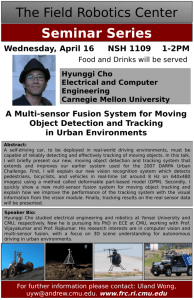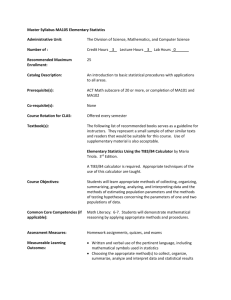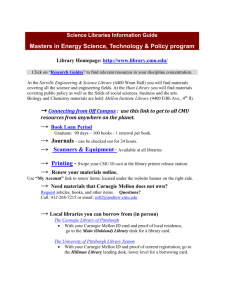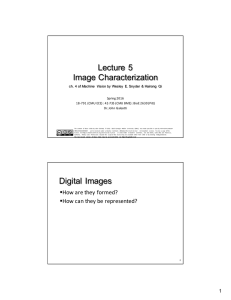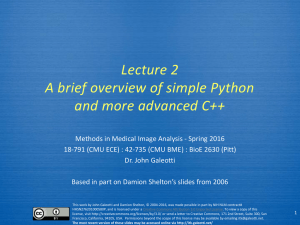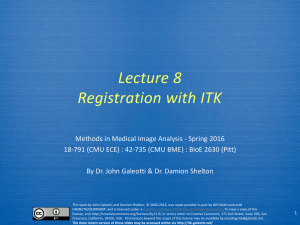Power Point - Visualization and Image Analysis (VIA) lab
advertisement
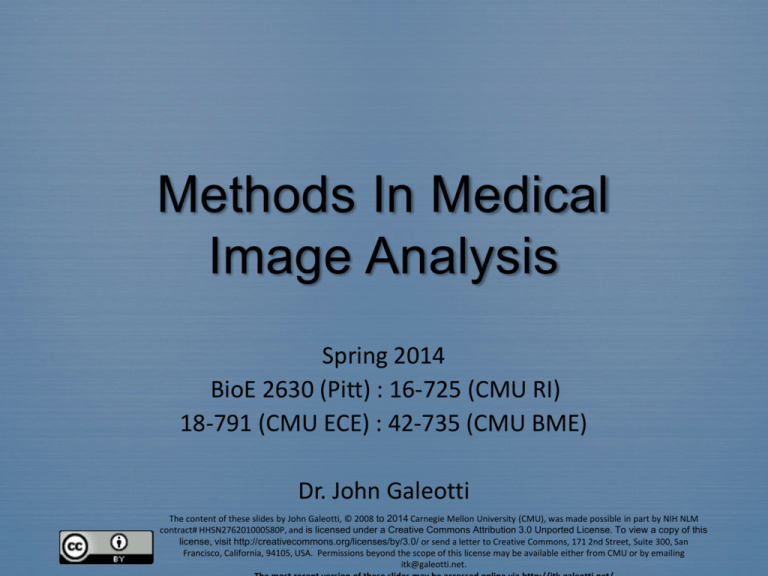
Methods In Medical Image Analysis Spring 2014 BioE 2630 (Pitt) : 16-725 (CMU RI) 18-791 (CMU ECE) : 42-735 (CMU BME) Dr. John Galeotti The content of these slides by John Galeotti, © 2008 to 2014 Carnegie Mellon University (CMU), was made possible in part by NIH NLM contract# HHSN276201000580P, and is licensed under a Creative Commons Attribution 3.0 Unported License. To view a copy of this license, visit http://creativecommons.org/licenses/by/3.0/ or send a letter to Creative Commons, 171 2nd Street, Suite 300, San Francisco, California, 94105, USA. Permissions beyond the scope of this license may be available either from CMU or by emailing itk@galeotti.net. What Are We Doing? Theoretical & practical skills in medical image analysis Imaging modalities Segmentation Registration Image understanding Visualization Established methods and current research 2 Why Is Medical Image Analysis Special? Because of the patient Computer Vision: Good at detecting irregulars, e.g. on the factory floor But no two patients are alike—everyone is “irregular” Medicine is war Radiology is primarily for reconnaissance Surgeons are the marines Life/death decisions made on insufficient information Success measured by patient recovery You’re not in “theory land” anymore 3 What Do I Mean by Analysis? Different from “Image Processing” Results in identification, measurement, &/or judgment Produces numbers, words, & actions Holy Grail: complete image understanding automated within a computer to perform diagnosis & control robotic intervention State of the art: segmentation & registration 4 Segmentation Labeling every voxel Discrete vs. fuzzy How good are such labels? Gray matter (circuits) vs. white matter (cables). Tremendous oversimplification Requires a model 5 Registration Image to Image same vs. different imaging modality same vs. different patient topological variation Image to Model deformable models Model to Model matching graphs 6 Visualization Visualization used to mean to picture in the mind. Retina is a 2D device Analysis needed to visualize surfaces Doctors prefer slices to renderings Visualization is required to reach visual cortex Computers have an advantage over humans in 3D 7 Model of a Modern Radiologist 8 How Are We Going to Do This? The Shadow Program Observe & interact with practicing radiologists and pathologists at UPMC Project oriented C++ &/or Python with ITK New ITKv4! National Library of Medicine Insight Toolkit A software library developed by a consortium of institutions including CMU and UPitt Open source Large online community www.itk.org 9 The Practice of Automated Medical Image Analysis A collection of recipes, a box of tools Equations that function: crafting human thought. ITK is a library, not a program. Solutions: Computer programs (fully- and semi-automated). Very application-specific, no general solution. Supervision / apprenticeship of machines 10 Who Are We? Personal introductions Name Academic Background (ECE, Biology, etc.) Research Interest Why you’re here Homework 1: email the TA/grader & myself the requested info about yourself, and a photo. (photo is optional, but requested; please crop to your head and shoulders) See website for HW1 details. 11 Syllabus On the course website http://www.cs.cmu.edu/~galeotti/methods_course/ Prerequisites Vector calculus Basic probability Knowledge of C++ and/or Python Helpful but not required: Knowledge of C++ templates & inheritance 12 Class Schedule Comply with Pitt & CMU calendars Online and subject to change Big picture: Background & review Fundamentals Segmentation, registration, & other fun stuff More advanced ITK programming constructs Review scientific papers Student project presentations 13 Requirements and Grading Attendance: Required (quizzes) Quizzes: 20% Lowest 2 dropped Homework: 30% Shadow Program: 10% Final Project: 40% 15% presentation 25% code 14 Textbooks Required: Machine Vision, Wesley E. Snyder & Hairong Qi Recommended: Insight into Images: Principles and Practice for Segmentation, Registration and Image Analysis, Terry S. Yoo (Editor) Others (build your bookshelf) 15 Anatomical Axes Superior = head Inferior = feet Anterior = front Posterior = back Proximal = central Distal = peripheral 16

